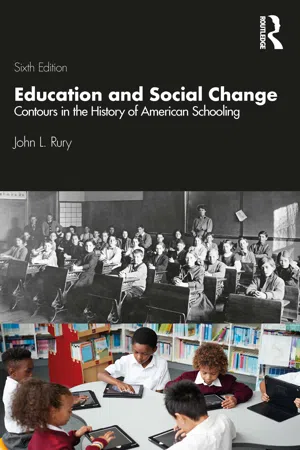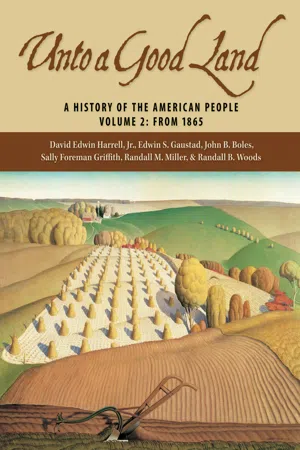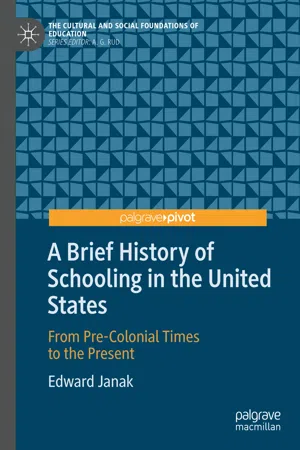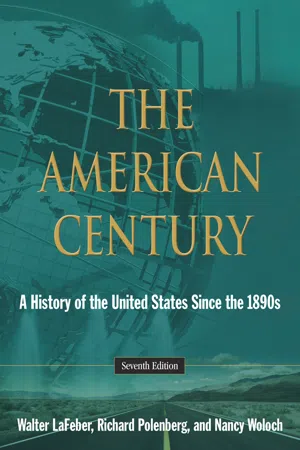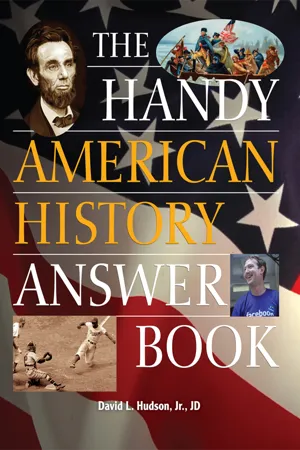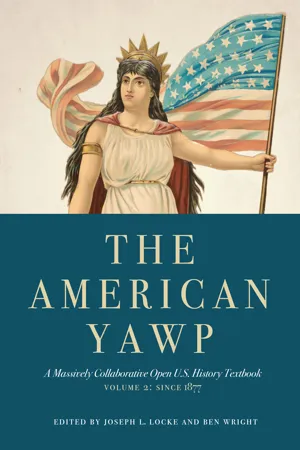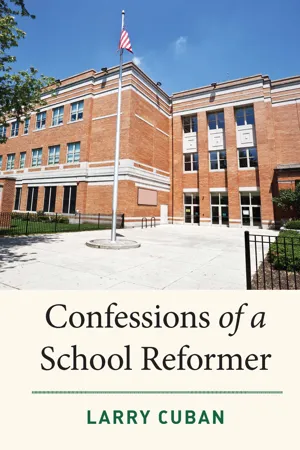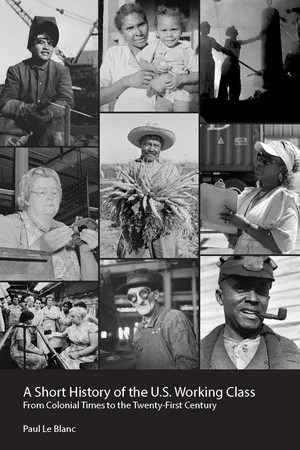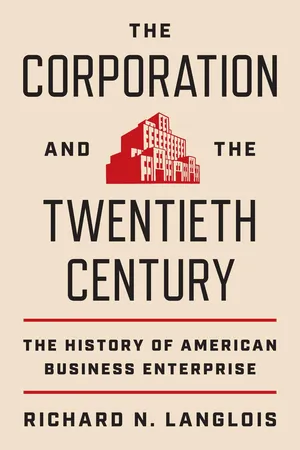History
The Progressive Era
The Progressive Era in the United States, spanning from the late 19th century to the early 20th century, was characterized by social and political reform efforts aimed at addressing issues such as corruption, inequality, and industrialization. Key initiatives included the regulation of big business, labor reforms, women's suffrage, and the conservation of natural resources. This period marked a significant shift towards a more activist government and a focus on social welfare.
Written by Perlego with AI-assistance
Related key terms
11 Key excerpts on "The Progressive Era"
- eBook - ePub
Education and Social Change
Contours in the History of American Schooling
- John L. Rury(Author)
- 2019(Publication Date)
- Routledge(Publisher)
4Growth, Reform, and Differentiation
The Progressive Era
On January 1, 1901, Americans enthusiastically greeted the 20th century, proclaiming it a time of boundless possibility. Although many prophecies proved far-fetched, the general sentiment was contagious. From the standpoint of social change, the opening decades of the new era were among the most momentous in history. It was a time of tremendous economic development and widespread reform. A modern urban civilization burst into view, raising a host of new social questions. Many of today’s public institutions and policies took shape then, including the school system.The period between 1890 and 1920 is often called The Progressive Era. The phrase conveys a sense of improvement or progress that many felt, especially regarding social reform. It reflected the influence of such leaders as Teddy Roosevelt and Woodrow Wilson, and the muckraking journalism of Ida Tarbell, Jacob Riis, and Lincoln Steffens, among others. Schools were an important aspect of this; it was a time of many new educational ideas and practices. In fact, a major current of pedagogical thought has been labeled “progressive education” ever since. This has been a recurring source of controversy and debate, but continues to inspire many educators today. Consequently, understanding progressivism in education is an important reason to examine this period (Goldman, 1952; Hofstadter, 1955b; May, 1964).Education and social reform, however, did not dictate the basic tenor of the age. Rather, forces of industrialization and urban growth defined it, factors that had spurred change in earlier times. The difference was magnitude and pace. By the 20th century, the degree of industrial development and urbanization had reached levels scarcely imaginable decades earlier. Corporate enterprises reached a mammoth scale, serving far-flung markets with new technologies designed for mass production. Industrial expansion accelerated, boosting international trade and migration. The country was losing its pastoral character in the wake of incipient globalization (O’Rourke & Williamson, 2001). Cities swelled as millions of immigrants arrived to seek jobs. Cultural diversity became even more pronounced and dozens of languages could be heard on the streets. American society seemed to be rapidly changing in ways difficult to fathom (Hays, 1957/1995; Higgs, 1971; Rodgers, 1998). This became a source of new anxieties, and eventually a focal point for reform. As noted by historian Robert Wiebe, a “search for order” became emblematic of a new stage in American history (Wiebe, 1967). - eBook - ePub
Unto a Good Land
A History of the American People, Volume 2: From 1865
- David Edwin Harrell, Edwin S. Gaustad, John B. Boles, Sally Foreman Griffith(Authors)
- 2005(Publication Date)
- Eerdmans(Publisher)
National progressivism crested in the election of 1912, an exciting campaign that pitted all three of the era’s presidents against each other and for good measure added a vigorous challenge from the Socialist party. World War I brought domestic reform to an end in 1917, but, if we can refrain from imposing post-war moods on earlier times, The Progressive Era was a time of lofty aspirations and notable accomplishments.THE CORE OF THE PROGRESSIVE AGENDAAlthough certain common threads ran through progressive thought—a confidence in progress and the ability of human beings to change society for the better, a belief in a moral social and economic order, and a nostalgia for the individualism and egalitarianism of America’s agrarian past—the specific causes backed by progressive reformers varied, as did their solutions. Some reforms received nearly universal support and were widely debated political issues during The Progressive Era; others failed to attract the kind of coalition necessary to demand serious political consideration.Two complexes of individuals and organizations were centers of lobbying influence—one primarily secular, the other religious. The urban social justice movement, led by social scientists, fostered crusades for political efficiency and honesty, the acceptance of cultural pluralism, and fairness in providing opportunity for the poor. Protestant churches, equally disturbed by the disarray of American society, urged government restrictions on immorality as a means of restoring order.The Urban Social Justice Movement
In 1900 crusading journalist Jacob Riis observed that the worst of New York City’s slums were gone, replaced by parks, playgrounds, and improved housing. Late nineteenth-century urban reform had improved many neighborhoods. But despite this progress, in most cities in 1900 slums remained filthy, unhealthy, and dangerous places to live.The growth of cities continued at a rapid pace in the first two decades of the century, highlighted by the census report in 1920 that, for the first time, more than 50 percent of the population lived in towns with populations of more than 2,500. That landmark of the transition to an urban society had probably been reached around 1914 and, excluding the still overwhelmingly rural South, had occurred early in the twentieth century. Some cities grew to enormous size; the population of New York City reached 5.6 million by 1920, Chicago 2.7 million, and Philadelphia 1.8 million. About half of the nation’s urban dwellers lived in cities with a population of 100,000 or more. - eBook - ePub
Land of Hope
A History of the United States
- Wilfred M. McClay(Author)
- 2020(Publication Date)
- Encounter Books(Publisher)
CHAPTER FOURTEEN The Progressive EraH ISTORIANS HAVE LONG REFERRED TO THE NEARLY TWO decades between the Spanish–American War and the American entry into the First World War as The Progressive Era. The term has its uses but can easily mislead. Yes, the years between 1898 and 1917 may have represented a high tide for a certain approach to reform, in which activist intellectuals and politicians, many of them associated with a loose movement that came to be called Progressivism, sponsored programs of far-reaching structural change to political and economic institutions. But it is not as if there were no reform ideas or efforts being promoted before 1898, and none again after 1917, and it was not as if those ideas were less sweeping or far-reaching than those of the people who are called Progressives.What we call The Progressive Era was a more concentrated and widely influential phase in a longer and more general response to the great disruptions of industrialization, urbanization, national consolidation, and concentrated wealth and power. In that phase, the reformers achieved political power, even the presidency, and enacted significant portions of their reform agenda. Such responses were part of a larger quest for a new order, or at least for a new way of thinking about how American democracy and self-rule could survive and thrive under such dramatically changed conditions. We still struggle with some of those same questions today.But The Progressive Era had an important prologue, which began with scattered visionaries who attracted large followings, offering radical innovations to solve the nation’s problems. Some of their solutions were quite novel. The San Francisco journalist Henry George, in an 1879 book called Progress and Poverty, called for a single tax on land, termed a land value tax, as a way to equalize the alarming inequalities of wealth that he had observed in the cities. The many disruptions wrought by nineteenth-century industrialization also led to a rash of utopian novels, perhaps best exemplified by Edward Bellamy’s fabulously best-selling 1888 fantasy Looking Backward, an effort to imagine a perfected postindustrial Boston, reconstituted as a socialist cooperative commonwealth in the year 2000. Far from celebrating individualism, Bellamy openly reviled it, proposing in its place a quasi-Christian “religion of solidarity” that would radically deemphasize the self and instead promote social bonds over individual liberty. The huge popularity of Bellamy’s book – it was second only to Uncle Tom’s Cabin - eBook - ePub
A Brief History of Schooling in the United States
From Pre-Colonial Times to the Present
- Edward Janak(Author)
- 2019(Publication Date)
- Palgrave Pivot(Publisher)
Overcrowded, crime-ridden slums. Political corruption. Economic instability. Class stratification. Alcoholism. War. Racism. Anti-immigrant bias. Farm outmigration. Industrial abuse of workers. Corporations dictating society. Business leaders out-earning their actual worth. Technology taking over factories. Jobs being lost or moving overseas. While this sounds like a laundry list of the challenges that face our society today, these were in fact but some of the challenges taken on chiefly between 1890 and 1930, the period known as The Progressive Era. While representing a relatively brief period of time, due to the laundry list of sociopolitical reforms that came out, this is one of the most revolutionary in the US history and included the following: Pure food and drug laws, including the Food and Drug Administration Direct election of senators and women’s suffrage Prohibition (and its eventual repeal) City manager government, civil service reform, social bonds, and the citizen’s initiative Sanitation reform and tenement regulation Trust busting, child labor laws, and unionization The cult of efficiency Just as there was tremendous social upheaval that caused thinkers such as Horace Mann to take on the purpose of schooling, the political and social challenges facing reformers in this period caused a significant overhaul of the public schools. Reforms came on every level of schooling, from the frazzled teacher in the one-room schoolhouse on the prairie to the equally frazzled teacher of English in the large urban school that was running more and more like a factory - eBook - ePub
The American Century
A History of the United States Since the 1890s
- Walter LaFeber, Richard Polenberg, Nancy Woloch(Authors)
- 2015(Publication Date)
- Routledge(Publisher)
HAPTER TWO 1900—1917The Progressive EraSuffragists on a picket line in front of the White House. One banner reads, "Mr. President How Long Must Women Wait For Liberty." (Library of Congress)An interest in reform has always characterized American history. What varied over time has been the things people identified as evils, the intellectual justifications and political techniques used to eradicate those evils, the obstacles reformers encountered, and the degree of support those reforms received. Seldom has a larger proportion of the population favored social improvement than during the opening years of the twentieth century, when Americans first tried in a systematic way to control the forces of industrialization and urbanization. Because the United States was becoming a major world power, the successes and failures of the Progressive movement affected not only Americans but also people around the world.The Reform Impulse
Although progressivism followed on the heels of the Populist revolt and sometimes echoed certain Populist demands, the two movements differed in important respects. Populism had drawn support primarily from farmers and had always remained a sectional force; progressivism won backing from city dwellers, including the middle classes, and had as wide a following in New York and California as in Kansas and South Carolina. Populists had sought for the most part to improve conditions in the countryside; Progressives devoted considerably more attention to political and social problems in the cities. Precisely because Progressives drew on a wider constituency and were concerned with a broader range of issues, they achieved a measure of influence at the city, state, and national levels that had eluded the Populists.Progressives did, however, pay a price for this success. So many different people wanting so many disparate things styled themselves "Progressives" that the movement often seemed to lack a clearly defined program. Progressivism attracted surprisingly diverse groups: small businessmen who favored a curb on monopolies, and big businessmen who sought to extend their economic influence and eliminate their competitors; native Americans who feared the influx of eastern European immigrants, and settlement-house workers who appreciated the newcomers' contributions to American culture; southern whites dedicated to the preservation of Jim Crow, and northern blacks just as fully committed to its eradication; social scientists who believed that planning held all the answers to human progress; and prohibitionists who imagined that closing the saloons would usher in a new world. - eBook - ePub
- David L. Hudson(Author)
- 2015(Publication Date)
- Visible Ink Press(Publisher)
President Taft signed into law the Mann–Elkins Act of 1910, giving the ICC more authority over railroad rates. It also gave the ICC control over the telephone and telegraph industries. Congress abolished this agency in 1995.The Progressive Era What was The Progressive Era?The Progressive Era was a period of American history from the late 1880s to the 1920s marked by increasing governmental regulation of business, social reform, and prohibition of exploitative labor practices. The administrations of numerous presidents—most notably Theodore Roosevelt (1858–1919) and Woodrow Wilson (1856–1924)—featured elements of Progressivism. The Progressive Era was not confined to a single political party, as segments of both of the two major political parties—the Democrats and the Republicans—embraced Progressive causes.The Progressive Era saw an expansion of governmental power, an increase in suffrage for women, anti-trust legislation, a push for modernization, the support of Prohibition, an increase in educational opportunities, and a greater emphasis placed on science and medicine.What was the Progressive Party?The Progressive Party was created in 1912 to serve as a separate third party to compete with the more traditional Republican and Democratic Parties. The party was formed largely to support the presidential ambitions of former Republican President Theodore Roosevelt, who had left office in 1909. Roosevelt’s successor was his former secretary of war, William Howard Taft (1857–1930), who later became U.S. Supreme Court chief justice. Roosevelt and Taft split politically, as Roosevelt believed Taft had become too conservative and abandoned Roosevelt’s more progressive causes.Roosevelt then formed the Progressive Party to run in the 1912 presidential election. The Progressive Party was also known as the Bull Moose Party. Roosevelt and Taft split the Republican vote, leading to a landslide election victory for the Democratic candidate, Woodrow Wilson (1856–1924). The Progressive Party continued for a few years but never gained respect equal to that of the two major parties. It gradually disappeared from the political scene. - eBook - ePub
The American Yawp
A Massively Collaborative Open U.S. History Textbook, Vol. 2: Since 1877
- Joseph L. Locke, Ben Wright(Authors)
- 2019(Publication Date)
- Stanford University Press(Publisher)
20 The Progressive EraI. IntroductionAn undated William Jennings Bryan campaign print titled Shall the People Rule? Library of Congress.“Never in the history of the world was society in so terrific flux as it is right now,” Jack London wrote in The Iron Heel , his 1908 dystopian novel in which a corporate oligarchy comes to rule the United States. He wrote, “The swift changes in our industrial system are causing equally swift changes in our religious, political, and social structures. An unseen and fearful revolution is taking place in the fiber and structure of society. One can only dimly feel these things, but they are in the air, now, today.”1The many problems associated with the Gilded Age—the rise of unprecedented fortunes and unprecedented poverty, controversies over imperialism, urban squalor, a near-war between capital and labor, loosening social mores, unsanitary food production, the onrush of foreign immigration, environmental destruction, and the outbreak of political radicalism—confronted Americans. Terrible forces seemed out of control and the nation seemed imperiled. Farmers and workers had been waging political war against capitalists and political conservatives for decades, but then, slowly, toward the end of the nineteenth century a new generation of middle-class Americans interjected themselves into public life and advocated new reforms to tame the runaway world of the Gilded Age.Widespread dissatisfaction with new trends in American society spurred The Progressive Era, named for the various progressive movements that attracted various constituencies around various reforms. Americans had many different ideas about how the country’s development should be managed and whose interests required the greatest protection. Reformers sought to clean up politics; black Americans continued their long struggle for civil rights; women demanded the vote with greater intensity while also demanding a more equal role in society at large; and workers demanded higher wages, safer workplaces, and the union recognition that would guarantee these rights. Whatever their goals, reform - eBook - ePub
- Larry Cuban(Author)
- 2022(Publication Date)
- Harvard Education Press(Publisher)
For example, Republican President Teddy Roosevelt and Democratic President Woodrow Wilson called themselves Progressives. Philosopher John Dewey and measurement expert Edward Thorndike belonged to the movement. Settlement house founder Jane Addams and teacher union leader Margaret Haley saw themselves as Progressives. Efficiency expert Frederick Winslow Taylor and wealthy businessman and later Illinois Governor John Altgeld considered themselves Progressives. A polyglot bunch of reformers in government, business, community improvement, and education sheltered under the wide umbrella called Progressivism.Even a century later, historians cannot yet agree on a definition of Progressivism, who led the movement, what areas of American life were substantively altered as a result of the movement, and how long the movement lasted. So if historians today differ on answers to such basic questions, readers may be disappointed that I cannot do better than my peers in answering these questions.7What historians do agree on, however, are the impulses that drove those who called themselves Progressives to work hard for decades to improve American society. Moving from largely rural agriculture in the eighteenth and nineteenth centuries to an industrial and urban-based economy in the decades following the Civil War transformed the economy, society, and culture of the nation. Steel, beef, and oil trusts, as these monopolies were then called, paid low wages for workers and set high prices for consumers. Cities grew as manufacturing and transportation centers. Rural migrants and European immigrants flocked to these cities to get jobs that paid barely enough to cover rent and food.Political machines oiled by bribery and nepotism governed these urban centers, caring little for the disease, crime, and poverty endemic to densely packed slums. Reform-minded mayors pledging to solve these problems came and went, but political machines endured. Worsening conditions even more were the unpredictable and periodic economic panics (1873 and 1893) that threw hundreds of thousands of workers out of jobs, overwhelmed city leaders, and frightened city-dwelling middle-class families, many of whom had moved into emerging suburbs. - eBook - ePub
Teaching U.S. History
Dialogues Among Social Studies Teachers and Historians
- Diana Turk, Rachel Mattson, Terrie Epstein, Robert Cohen(Authors)
- 2010(Publication Date)
- Routledge(Publisher)
History textbooks typically present Progressivism as the ideological impetus for considerable social, political, and legal reform in the United States between 1880 and 1920. Traditional narratives associate the movement with a popular vision of white middle-class women promoting reform in urban areas and a marked increase in social services through both private initiative and legislative action. Yet Progressivism was, like many movements for social justice, pluralistic. Indeed, historians (e.g. Connolly, 1998; Gilmore, 1996; Link 1992; Montgomery, 2006) have demonstrated that a myriad of religious and ethnic groups participated broadly in reform initiatives and employed progressive rhetoric to their own ends. Additionally, Rodgers (1982) argues that these reformers were not united around a common social or political ideology, but rather shared a common set of practical concerns such as social efficiency, community improvement, health and cleanliness, and education. In this light, the era provides a complexity that lends itself to considerations of identity and, especially, issues of race, class, and gender. However, it is often easier to reduce this topic in the classroom to a more straightforward description of reform without the complicated nuance.It is difficult in the high school classroom to move creatively beyond the standard accepted historical narrative about any time period, but The Progressive Era is particularly challenging because the term “progressive” has come to have several different meanings. The lesson developed by this group was an attempt to bring nuanced historical notions of Progressivism into the high school classroom. It required significant planning, the development of new materials, additional research, and integration with the mandated curriculum. It also required that educators explicitly confront issues of race, class, and gender in their classrooms. Even when presented in historical context, these issues complicated classroom discussion in the present. The concepts evoked particular feelings from students, and class discussion required that the teachers mediate with skill and sensitivity. At the same time, students learned to set aside emotional reactions and analyze information from an historical rather than a presentist perspective. Thus, the students were able to engage in a sophisticated discussion of progressive reformers and to develop a more mature conception of the disciplinary practice of history. - eBook - ePub
A Short History of the U.S. Working Class
From Colonial Times to the Twenty-First Century (Revolutionary Studies)
- Paul Le Blanc(Author)
- 2017(Publication Date)
- Haymarket Books(Publisher)
chapter 8 Progressive EraBy the mid-1890s, the United States was the leading manufacturing nation in the world, and by 1900 it had entered the ranks of the major powers in world politics. And yet, the tremendous industrial development that had made this possible created immense social problems which worried some of the more farsighted business and political leaders. There were more and more exposures of and protests against a vast accumulation of evils and injustices: unsafe and unsanitary workplaces and communities, outright political corruption on an unprecedented scale, the enhancement of big business profits through large-scale environmental destruction, generalized fraud and cheating at the public expense, the widespread adulteration and pollution of consumer goods, innumerable and unavoidable manifestations of poverty side-by-side with conspicuous consumption by the wealthy, shocking realities of child labor, etc. Theodore Roosevelt favored the growth of big corporations and what he viewed as their positive contributions, but fretted: “I do not like the social conditions at present. The dull, purblind folly of the very rich men, their greed and arrogance . . . and the corruption in business and politics, have tended to produce a very unhealthy condition of excitement and irritation in the popular mind, which shows itself in the great increase in the socialistic propaganda.”Reformers and SocialistsSuch people concluded that if “progress” was to mean change for the better, then the government would have to play a more active role in society. Mainstream Progressive politicians such as the Republican Roosevelt and the Democrat Woodrow Wilson (elected president in 1912) rejected the old-time laissez-faire economic policies, favoring instead bold government intervention in the economy. They didn’t want to overthrow the power of the big corporations, but instead to set limits on and establish regulations for that power. At the same time, they favored major social reforms to eliminate some of the worst of the problems created by the previous decades of industrialization. They even adopted a policy of encouraging the more “responsible” and moderate union leaders—such as the AFL’s Samuel Gompers—who would help advance such reforms while at the same time drawing workers away from socialists and other radicals. - eBook - ePub
The Corporation and the Twentieth Century
The History of American Business Enterprise
- Richard N. Langlois(Author)
- 2023(Publication Date)
- Princeton University Press(Publisher)
3
The Progressive Era
The successful conduct of both public and private business is becoming more and more a matter of expert administration, which demands the use of similar methods and is confronted by the solution of similar problems.—HERBERT CROLYBeginning sometime in the second half of the nineteenth century, those who had the greatest public spirit and the keenest human sympathies felt that they could not adapt the social order to the new economy by vindicating the supremacy of the law. They came up against the dead end of the negation of laissez-faire, lost their way, and took the path that leads back to the supremacy of men.—WALTER LIPPMANNAS THE united states entered the twentieth century, gold discoveries in South Africa, Alaska, and Colorado, along with a technological breakthrough in the refining of gold, began to do what the populists had hoped for from silver: between 1896, the year of William Jennings Bryan’s defeat in the presidential election, and 1914, the world stock of gold grew significantly. At the same time, bountiful harvests in America, coupled with crop failure abroad, led to a dramatic rise in exports and a concurrent inflow of gold to pay for them. The price level in the US increased by at least 44 percent over the period, about 2 to 2.5 percent a year, the most sustained peacetime inflation the country had ever had.1 Bryan’s political fortunes sank as a result, and he lost two more presidential elections by increasing margins. Yet as many commentators have noted, Bryan was in the end the victor. For in the twentieth century, despite waning populist power, most of the political program of the populists was voted into place, often by the very players who had opposed the populists in the nineteenth century.2The early twentieth century would be the era of the Progressive movement. Although Progressives would certainly not be the only political force at work, their ideas would be crucial in giving direction to public policy toward business over the century. Like Alfred Chandler—indeed, far more intensely than Chandler—the early-century Progressives were impressed with the power of scientific management and administrative planning, seeing these techniques as essential in government as well as business. For many, including some of the leaders of the giant corporations that had emerged at the turn of the century, this naturally implied a centralized regulatory structure in which experts in business cooperated with their counterparts in the state. By contrast, a dissident strain of Progressivism, epitomized by Louis D. Brandeis, feared centralization and demanded the construction of decentralized structures of business and government, albeit structures necessarily created and kept in place by a centralized state. Out of the prewar tussle between these competing views would emerge institutions of regulation, antitrust, and monetary policy that would shape and constrain the trajectory of the corporation throughout the twentieth century.
Learn about this page
Index pages curate the most relevant extracts from our library of academic textbooks. They’ve been created using an in-house natural language model (NLM), each adding context and meaning to key research topics.
